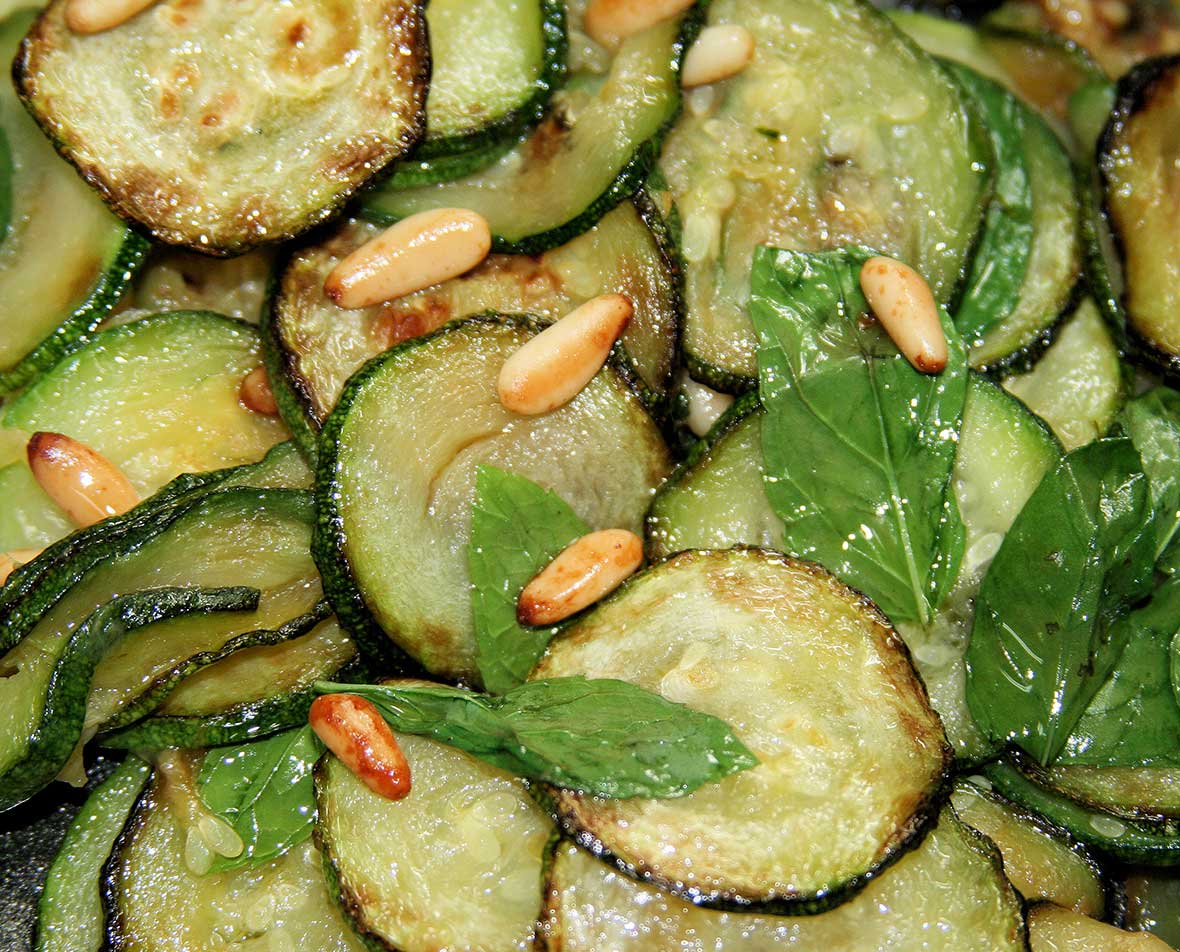
Basil, Ocimum Basilicum, comes from the Greek word meaning king. Used in Italian cooking is also known as Sweet Basil. With more than 100 varieties grown throughout the world, such as Thai, holy, purple, and lemon basil, each one yields different flavors to food. Considered the best in Italy is Basilico di Pra, a type of Basilico Genovese grown in the town of Pra along the Ligurian coast of the Mediterranean, west of Genoa. It is thought the air of Pra gives a special perfume and taste to basil, and from tasting it, I agree. Many annual varieties require sunny conditions, but moderate heat, so indirect sun is best. Lots of watering and a slight breeze give huge bunches to enjoy during middle-to-late summer.
Traditions: Introduced into Europe from India, basil has been associated with both good and evil. It was a symbol of fertility and considered an aphrodisiac for many cultures, including the French and Romans. (Hasn’t changed in centuries.) Did you know this immensely popular herb was also feared and associated with misfortune and hatred? On the island of Crete, when sowing its seeds in gardens, chants were recommended as dispelling its negative associations. We prefer the more positive spin and the Cahors idea of floating fresh leaves in red wine, a love potion?
Applications: Basil has been used to treat jaundice, epilepsy, and is used as a diuretic. It combats free radical damage, relieves congestion, and has been used to counter ear infections. During the Middle Ages, it was used to treat melancholy and depression; smell some leaves and test for yourself, its fragrance definitely brightens one's outlook.
Chinese Medicine: The basil plant is considered warm and pungent. Consumption promotes energy, blood circulation, and digestion. Cooking sweet basil with chicken eggs, or with ginger, scallion, and meat or fish, reduces menstrual pain. Basil seeds are prescribed for eye issues, in particular, opacity of the cornea, to remove films and opacity as well as soothe pain and reduce inflammation.
Basil Essential Oil: Frequency 52 MHz. Basil oil possesses compounds known for potent anti-oxidant, anti-viral, and anti-microbial properties. It is used to treat colds, influenza, and muscle aches. It reduces inflammation and has been used to treat wounds, bites from venomous snakes, insects, and wasp stings. It is recommended for women to help lessen the difficulties of menstruation and menopause by rubbing on stomachs and the solar plexus area. Refreshing and fortifying the nervous system, it is known for being effective in treating nervous fatigue, tiredness, migraine headaches. If your sense of smell is reduced or lost, try putting a drop of basil oil in a bowl of hot water, then inhale for a few minutes; repeat this a few times each day until improved. A natural antiseptic, mix a few drops of basil oil in warm water and use this to clean counters, floors, pet beds, etc. It improves circulation and strengthens the immune system.
Culinary Uses: Fresh basil leaves add a subtle flavor in many dishes during cooking. Be sure to add more at the very end of cooking for additional intensity of flavor since its essential oils dissipate quickly. Raw leaves are especially good in salads (as are the delicate white flowers), on top of pizza, pasta sauce, and eggs. Many main protein ingredients benefit with basil flavoring, from cheese and tofu to meats, poultry, and fish. Cooking with this herb is wonderful for many vegetables, especially eggplant, green beans, peas, peppers, tomatoes, and zucchini. If the harvest is prolific and you’re swamped with excess, infuse extra-virgin olive oil with fresh leaves and store in your refrigerator. Make a thick pureé of leaves, a pesto, cover with a layer of olive oil to prevent discoloration and store up to a few weeks in your refrigerator or freeze up to one month.
To capture basil’s delicate essence, it is best to serve it as the only herb. If combining it with other fresh herbs, pair it with fresh parsley and/or mint. When using basil in pasta sauce or other cooked dishes, please add it at the last moment, even if you added some during cooking, and serve the dish immediately so your guests smell the enticing perfume and enjoy its light taste. Fry whole leaves in hot oil for several seconds, drain, and serve as a garnish for fish dishes. For an unusual and pleasing twist, make thin julienne of fresh leaves and sprinkle it over a chocolate dessert or fresh fruit. Next time you are traveling in Liguria or visiting Genoa, be sure to sample the special basil grown in this area. It’s a treat!
* This synopsis imparts valuable information that could be beneficial as part of a wellness program. Its purpose is to open the thought process to consider including herbs and spices as natural supplements in personal regimens. Briefly stating how the plant was valued and used historically in different ages and cultures, it lists some current uses. If interested in this particular plant, please extend your research via books and articles for more details and uses.
With increasing interest for including alternative therapies with standard drug therapy, research continues, so this topic evolves continuously. Please consult your wholistic and holistic practitioners, homeopaths, nutritionists, dentists, and physicians to keep yourself updated if you choose to incorporate or ingest the plant in any form for medical purposes.















